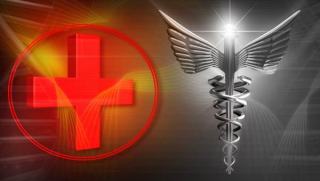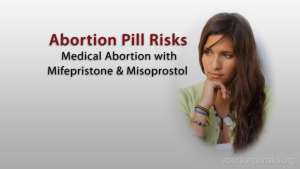Advisories, Reports & Updates
RISK WARNINGS: MEDICAL ABORTION ANNOUNCEMENTS
 |
What Are The Risks?
Learn About Important Historical FDA Announcements On Medical Abortion Risks.
|
On This Page:
- Overview of FDA Announcements
- 07/19/2011: Postmarketing Adverse Events Summary Report
- 06/08/2011: Mifepristone Risk Evaluation & Mitigation Strategy
- 01/24/2010: Eight Women Die From Medical Abortion Infection
- 09/11/2009: Cytotec (misoprostol) Labeling Revision
- 05/15/2009: Misoprostol Risks For Use In Labor
- 04/27/2009: Serious Infections Result in Death
- 03/17/2006: Sepsis and Medical Abortion With Mifepristone
- 11/04/2005: C. Sordellii Lethal Infection
- 07/19/2005: Risk of Sepsis From Mifepristone Use
- 11/14/2004: Risk Warnings Added To Mifepristone Label
- 09/28/2000: Mifeprex (Mifepristone) Approval – 2000
- References
OVERVIEW OF FDA ANNOUNCEMENTS
What important health risk information has the U.S. Food and Drug Administration (FDA) announced?
Mifepristone (Mifeprex) and misoprostol was approved in 2000 for the termination of early pregnancy, defined as 49 days or less.
The U.S. Food and Drug Administration (FDA) has previously announced:
- Important adverse events reports, including death, on the serious risks of mifepristone and misoprostol for medical abortion.
- Public health risk advisories for mifepristone and misoprostol.
- Updates to Danco Laboratories, LLC's labeling of mifepristone (trade name Mifeprex, also known as RU-486).
- Updates to G.D. Searle LLC, Division of Pfizer Inc., labeling of misoprostol (trade name Cytotec).
POSTMARKETING ADVERSE EVENTS SUMMARY REPORT: 9/28/2000 – 04/30/2011
FDA Releases Adverse Events Report on the Risks of Medical Abortion
July 19, 2011 (Public Release Date for April 2011 Adverse Event Summary)
Adverse Event: Unanticipated problem involving drug “risk” to patients that at any dose ultimately results in harm to patients.
The event is serious and should be reported to FDA when the patient outcome is: (1)
- Death
- Life- threatening (patient at substantial risk of dying)
- Hospitalization (initial or prolonged)
- Required Medical or Surgical Intervention to Prevent Permanent Impairment or Damage
Post-Marketing Adverse Events in U.S. Women Who Used Mifepristone for Termination of Pregnancy (2)
The estimated number of women who have used mifepristone in the U.S. through the end of April 2011 is approximately 1.52 million women.
Adverse Event Summary Report dates were from approval date in the U.S. (September 28, 2000 to April 30, 2011).
- 2207 women had Adverse Event Cases Reported to the FDA.
- 14 women Died from mifepristone/misoprostol medical abortions. Deaths include sepsis, toxic shock-like syndrome, ruptured ectopic pregnancy, multivisceral failure, and other causes.
- 612 women were Hospitalized, excluding deaths.
- 58 women had Ectopic Pregnancies (a pregnancy outside the uterus).
- 339 women experienced Blood Loss Requiring Transfusions.
- 256 women experienced Infections.
- 48 women experienced Severe Infections. Severe infections generally involve death or hospitalization for at least 2-3 days.
For More Information:
MIFEPRISTONE RISK EVALUATION & MITIGATION STRATEGY
FDA Requires Danco Laboratories to Provide Mifepristone Risk Evaluation and Mitigation Strategy (REMS) (4)
June 08, 2011
Health Risks: New Risk Evaluation and Mitigation Strategy (REMS)
The FDA identified MIFEPREX (mifepristone) as a product deemed to have in effect an approved Risk Evaluation and Mitigation Strategy (REMS) to assure safe use.
REMS Goals:
- To provide information to patients about the benefits and risks of mifepristone before they make a decision whether to take the drug.
- The FDA determined that the REMS is necessary for MIFEPREX (mifepristone) to ensure the benefits of the drug outweigh the risks of serious complications by requiring prescribers to certify that they are qualified to prescribe MIFEPREX (mifepristone) and are able to assure patient access to appropriate medical facilities to manage any complications.
For More Information:
- Supplemental Approval Letter (5)
- Medication Guide & Prescriber’s Agreement: Labeling Rev. 06/08/2011 (4)
EIGHT WOMEN DIE FROM MEDICAL ABORTION INFECTION
Eight Women Die from Serious Infection Involving the Bloodstream (6)
January 24, 2010
Health Risks: Eight Medical Abortion Deaths Due to Serious Infection
Mifeprex Questions and Answers: Number 18
Since the approval of Mifeprex in September 2000, FDA has been informed of eight deaths in the United States due to serious infections following medical abortion with mifepristone and misoprostol.
The FDA has concluded that these deaths may possibly be related to the use of these drugs.
These women died from sepsis (serious infection involving the bloodstream). Seven cases were found to involve infection with bacteria known as Clostridium sordellii and one case involved infection with Clostridium perfringens.
Sepsis is a known risk related to any type of abortion.
The symptoms in all of these cases of serious infection were not the usual symptoms of sepsis. We do not know whether using Mifeprex and misoprostol caused these deaths.
In all but one case, the misoprostol was used intravaginally.
For More information:
- Mifeprex Questions and Answers, Issued 08/29/2004, updated 02/24/2010 (6)
- Fatal Clostridium sordellii infections after Medical Abortions (7)
- Toxic Shock Associated With Clostridium sordellii and Clostridium perfringens After Medical and Spontaneous Abortion (8)
CYTOTEC (MISOPROSTOL) LABELING REVISION
Misoprostol (Cytotec) Labeling Updated with New Risk Warnings (9)
September 11, 2009
New Risk Warnings: Labeling Revision
Labeling changes were made to the following:
- Precautions and Adverse Reactions sections of the Package Insert.
- Caution should be employed when administering Cytotec (misoprostol) to patients with pre-existing cardiovascular disease.
Highlights of the Existing & Previous Labeling for Patient Information:
- Cytotec has been reported to cause the uterus to rupture (tear) when given after the eighth week of pregnancy.
- Rupture (tearing) of the uterus can result in severe bleeding, hysterectomy, and/or maternal or fetal death.
For More Information:
- Labeling Revision: Cytotec® (misoprostol tablets) (9)
MISOPROSTOL RISKS FOR USE IN LABOR
FDA Alert
New Risk Warnings for Misoprostol (marketed as Cytotec) (10)
May 15, 2009
New Risk Warnings: Risks of Use in Labor and Delivery
This Patient Information Sheet is for pregnant women who may receive misoprostol to soften their cervix or induce contractions to begin labor. Misoprostol is sometimes used to decrease blood loss after delivery of a baby.
These uses are not approved by the FDA. No company has sent the FDA scientific proof that misoprostol is safe and effective for these uses.
There can be serious side effects, including a torn uterus (womb), when misoprostol is used for labor and delivery.
A torn uterus may result in:
- severe bleeding,
- having the uterus removed (hysterectomy), and
- death of the mother or baby.
These side effects are more likely in women who have had previous uterine surgery, a previous Cesarean delivery (C-section), or several previous births.
For More Information:
SERIOUS INFECTIONS RESULT IN DEATH
Mifepristone (marketed as Mifeprex) Labeling Updated with New Risk Warnings for Infection & Sepsis (11)
April 27, 2009
New Risk Warnings: Warnings, Post Marketing Experience, Medication Guide
Labeling changes were made to the following:
- Warnings Section of Infection and Sepsis
- Post Marketing Experience section of Adverse Reactions.
Added Risks:
- pelvic infections and hemotometra (an accumulation of blood or menstrual fluid in the uterus)
Medication Guide Rev 3: 4/22/09: Serious infection has resulted in death, most of these cases misoprostol used in the vagina. Added: Call your doctor for medical advice about side effects.
You may report side effects to FDA at 1-800-FDA-1088.
For More Information:
- Labeling Revision: 04/27/2009 (11)
SEPSIS & MEDICAL ABORTION WITH MIFEPRISTONE
Public Health Advisory
Two more women die from mifepristone medical abortion
March 17, 2006
New Risk Warnings: Two Additional Medical Abortion Deaths
The Food and Drug Administration was informed of two additional deaths following medical abortion with mifepristone (Mifeprex).
All providers of medical abortion and their patients need to be aware of the specific circumstances and directions for use of this drug and all risks including sepsis when considering treatment.
In particular, physicians and their patients should fully discuss early potential signs and symptoms that may warrant immediate medical evaluation.
The FDA, in conjunction with the Centers for Disease Control and Prevention (CDC) and the National Institute of Allergy and Infectious Diseases (NIAID), is conducting a public workshop on May 11, 2006.
This scientific workshop entitled, “Emerging Clostridial Disease,” at the CDC Conference Center, Atlanta, Georgia, is being conducted to discuss the scientific and medical circumstances associated with reports of morbidity and mortality associated with C. sordellii and C. difficile infections.
For More Information:
- Public Health Advisory 3/17/2006 (12)
- Public Workshop on Emerging Clostridial Disease, 5/11/2006 (13)
C. SORDELLII LETHAL INFECTION
Public Health Advisory
Four Women Die from Clostridium Sordellii Infection after Medical Abortion (14)
November 4, 2005
Risk Warnings: FDA Update & Alerts, Four Septic (blood infection) Deaths Reported, Physicians Off-label Use of Mifepristone and Misoprostol, Antibiotic Use
All four cases of fatal infection tested positive for the anerobic bacteria known as Clostridium sordellii.
All cases involve the off-label dosing regimen consisting of 200 mg of oral Mifeprex followed by 800 mcg of intra-vaginally placed misoprostol.
The confirmed cases of Clostridium sordellii did not have the usual signs and symptoms of an infection.
All providers of medical abortion and emergency room health care providers should investigate the possibility of sepsis in patients who are undergoing medical abortion and present with:
- nausea, vomiting, or diarrhea and
- weakness with or without abdominal pain, and
- without fever or other signs of infection more than 24 hours after taking misoprostol.
At this time FDA does not have sufficient information to recommend the use of prophylactic antibiotics.
The safety and effectiveness of other Mifeprex dosing regimens, including use of oral misoprostol tablets intravaginally has not been established by the FDA.
All providers of medical abortion and their patients need to be aware of the risks of sepsis.
As more information becomes available, FDA will alert the public.
For More Information:
- Public Health Advisory 7/19/2005, updated 11/04/2005 (14)
- Information for Healthcare Professionals: Mifepristone (marketed as Mifeprex) 11/2005 (15)
RISK OF SEPSIS FROM MEDICAL ABORTION
Public Health Advisory
Four Women have died from Infections after Mifepristone Medical Abortion from September 2003 to June 2005.(16)
July 19, 2005
New Risk Warnings: Four Medical Abortion Deaths Reported, Changes to Black Box Label, Warnings, Physicians Off-label Use of Mifepristone and Misoprostol
The Food and Drug Administration (FDA) investigated recently reported serious adverse events associated with mifepristone (trade name Mifeprex, also known as RU-486).
As a result, the FDA issued a public health advisory highlighting the risk of sepsis or blood infection when undergoing medical abortion using Mifeprex (mifepristone) and misoprostol in a manner that is not consistent with the approved labeling.
Four cases of deaths from infection were reported from September 2003 to June 2005 following medical abortion with these drugs.
For More Information:
RISK WARNINGS ADDED TO MIFEPRISTONE LABEL
Mifepristone Deaths Reported: BOXED Warning Label Updated
November 15, 2004
New Risk Warnings: Another Death from Sepsis, Changes to Boxed Label and Warnings
FDA and Danco Laboratories have received reports on the risks of serious bacterial infection, bleeding, ectopic pregnancies that have ruptured, and death, including another death from sepsis (blood infection) that was recently reported to FDA.
These reports have led to the revision of the BOXED labeling.
Postmarketing Experience added to the labeling:
- Allergic reaction (including rash, hives, itching),
- hypotension (including orthostatic),
- lightheadedness, loss of consciousness,
- post-abortal infection (including endomyometritis, parametritis),
- ruptured ectopic pregnancy,
- shortness of breath, and
- tachycardia (including racing pulse, heart palpitations, heart pounding).
For More Information:
MIFEPREX (MIFEPRISTONE) APPROVAL – 2000
Mifepristone Medical Abortion Approved by the FDA in 2000
September 28, 2000
Risk Warnings: Black Box Warnings, Restricted Distribution, Physician Qualifications, Medication Guide, Patient Agreement, Rejection of Off Label Regimen, Waiver of Pediatric Study Requirement
The FDA rejected the off label, home use of a different (alternative) regimen with different drug doses. The off-label regimen was found not to provide substantial evidence for safety and efficacy. (23)
A Boxed or Black Box warning was added to label for special problems, particularly those that may lead to death or serious injury.
Boxed (Black Box) Warning in 2000
If Mifeprex (mifepristone) results in incomplete abortion, surgical intervention may be necessary. Prescribers should determine in advance whether they will provide such care themselves or through other providers.
Prescribers should also give patients clear instructions on whom to call and what to do in the event of an emergency following administration of Mifeprex.
Prescribers should make sure that patients receive and have an opportunity to discuss the Medication Guide and the PATIENT AGREEMENT.
For More Information:
- Office Memo to Population Council 9/28/2000 (23)
- Approval Letter to Population Council 9/28/2000 (24)
- Approval Label 9/28/2000 (25)
1. U.S. Department of Health & Human Services. Safety, What is a Serious Adverse Event? FDA, U.S. Food and Drug Administration. [Online] June 23, 2011. [Cited: July 19, 2011.] http://www.fda.gov/safety/medwatch/howtoreport/ucm053087.htm.
2. U.S. Department of Health & Human Services. Drugs, Postmarket Drug Safety Information for Patients and Providers, Related Information, Mifeprex Adverse Events Report as of April 2011. FDA, U.S. Food and Drug Administration. [Online] April 30, 2011. [Cited: July 19, 2011.] http://www.fda.gov/downloads/Drugs/DrugSafety/PostmarketDrugSafetyInformationforPatientsandProviders/UCM263353.pdf.
3. Gary, Margaret M and Harrison, Donna J. Analysis of Severe Adverse Events Related to the Use of Mifepristone as an Abortifacient, Annals Pharmacotherapy, 40(2) 191-7. NCBI, PubMed.gov. [Online] February 2, 2006. [Cited: July 19, 2011.] http://www.ncbi.nlm.nih.gov/pubmed/16380436.
4. U.S. Department of Health & Human Services. Drugs@FDA, Label and Approval History, Mifeprex, 06/08/2011 Labeling Revision. FDA, U.S. Food and Drug Administration. [Online] June 08, 2011. [Cited: July 16, 2011.] http://www.accessdata.fda.gov/drugsatfda_docs/label/2011/020687s014lbl.pdf.
5. U.S. Department of Health & Human Services. Drug@FDA, Label and Approval History, Mifeprex, Labeling Revision 06/08/2011, Supplemental Approval Letter. FDA, U.S. Food and Drug Administration. [Online] June 08, 2011. [Cited: July 16, 2011.] http://www.accessdata.fda.gov/drugsatfda_docs/appletter/2011/020687s014ltr.pdf.
6. U.S. Department of Health & Human Services. Drugs, Mifeprex Questions and Answers, 2/24/2010. FDA, U.S. Food and Drug Administration. [Online] February 24, 2010. [Cited: July 16, 2011.] http://www.fda.gov/Drugs/DrugSafety/PostmarketDrugSafetyInformationforPatientsandProviders/ucm111328.htm.
7. Meites, Elissa, Zane, Suzanne and Gould, Carolyn. Fatal Clostridium sordellii Infections after Medical Abortions. The New England Journal of Medicine. [Online] September 30, 2010. [Cited: July 16, 2011.] http://www.nejm.org/doi/full/10.1056/NEJMc1001014.
8. Cohen, Adam, et al., et al. Toxic Shock Associated With Clostridium sordellii and Clostridium perfringens After Medical and Spontaneous Abortion. Obstetrics & Gynecology, November 2007-Volume 110 -Issue 5 -pp 1027-1033. [Online] November 2007. [Cited: July 16, 2011.] http://journals.lww.com/greenjournal/fulltext/2007/11000/toxic_shock_associated_with_clostridium_sordellii.14.aspx.
9. U.S. Department of Health & Human Services. Drugs@FDA, Cytotec (misoprostol) Label and Approval History. FDA, U.S. Food and Drug Administration. [Online] September 11, 2009. [Cited: July 12, 2011.] http://www.accessdata.fda.gov/drugsatfda_docs/label/2009/019268s041lbl.pdf.
10. U.S. Department of Health & Human Services. Drugs, Misoprostol (marketed as Cytotec) Information, FDA Alert. FDA, U.S. Food and Drug Administration. [Online] May 15, 2009. [Cited: July 27, 2011.] http://www.fda.gov/Drugs/DrugSafety/PostmarketDrugSafetyInformationforPatientsandProviders/ucm111315.htm.
11. U.S.Department of Health & Human Services. Drugs@FDA, Label and Approval History, Labeling Revision. FDA, U.S. Food and Drug Administration. [Online] April 27, 2009. [Cited: July 16, 2011.] http://www.accessdata.fda.gov/drugsatfda_docs/label/2009/020687s015lbl.pdf.
12. U.S. Department of Heath & Human Services. Drugs, Public Health Advisory: Sepsis and medical abortion with mifepristone (Mifeprex). FDA, U.S. Food and Drug Administration. [Online] March 17, 2006. [Cited: July 16, 2011.] http://www.fda.gov/Drugs/DrugSafety/PostmarketDrugSafetyInformationforPatientsandProviders/DrugSafetyInformationforHeathcareProfessionals/PublicHealthAdvisories/ucm051298.htm.
13. U.S. Department of Health & Human Services. Drugs, News & Events, Public Workshop on Emerging Clostridial Disease, May 11, 2006, Atlanta, Georgia. FDA, U.S. Food and Drug Administration. [Online] May 11, 2006. [Cited: July 16, 2011.] http://www.fda.gov/Drugs/NewsEvents/ucm079335.htm.
14. U.S Department of Health & Human Services. Drugs, Public Health Advisory: Sepsis and Medical Abortion, November 4, 2005 Update. FDA, U.S. Food and Drug Administration. [Online] November 04, 2005. [Cited: July 16, 2011.] http://www.fda.gov/Drugs/DrugSafety/PostmarketDrugSafetyInformationforPatientsandProviders/DrugSafetyInformationforHeathcareProfessionals/PublicHealthAdvisories/ucm051734.htm.
15. U.S. Department of Health & Human Services. Drugs, Information for Healthcare Professionals: Mifepristone (marketed as Mifeprex). FDA, U.S. Food and Drug Administration. [Online] November 2005. [Cited: July 16, 2011.] http://www.fda.gov/Drugs/DrugSafety/PostmarketDrugSafetyInformationforPatientsandProviders/DrugSafetyInformationforHeathcareProfessionals/ucm085264.htm.
16. U.S. Department of Health & Human Services. News & Events, FDA Issues Public Health Advisory for Mifepristone, 07/19/2005. FDA, U.S. Food and Drug Administration. [Online] July 19, 2005. [Cited: July 16, 2011.] http://www.fda.gov/NewsEvents/Newsroom/PressAnnouncements/2005/ucm108462.htm.
17. U.S Department of Health & Human Services. Drugs, Historical Information on Mifepristone (marketed as Mifeprex), Mifeprex Label. FDA, U.S Food and Drug Administration. [Online] July 19, 2005. [Cited: July 16, 2011.] http://www.accessdata.fda.gov/drugsatfda_docs/label/2005/020687s013lbl.pdf.
18. Fischer, Marc, et al., et al. N Engl J Med., Fatal Toxic Shock Syndrome Associated with Clostridium sordellii after Medical Abortion, 353(22):2352-60. NCBI, Pub Med.gov. [Online] December 1, 2005. [Cited: July 16, 2011.] http://www.ncbi.nlm.nih.gov/pubmed/16319384.
19. U.S. Department of Health & Human Services. News & Events, FDA To Announce Important Labeling Changes for Mifepristone, 11/15/2004. FDA, U.S. Food and Drug Administration. [Online] November 15, 2004. [Cited: July 16, 2011.] http://www.fda.gov/NewsEvents/Newsroom/PressAnnouncements/2004/ucm108373.htm.
20. U.S. Department of Health & Human Services. Drug@FDA, Mifeprex (mifepristone), Label and Approval History, Labeling Revision. FDA, U.S. Food and Drug Administration. [Online] November 15, 2004. [Cited: July 13, 2011.] http://www.accessdata.fda.gov/drugsatfda_docs/label/2004/020687s010-lbl.pdf.
21. U.S. Department of Health & Human Services. Drugs, Historical Information on Mifepristone, 11/15/2004 Dear Health Professional. FDA, U.S. Food and Drug Adminstration. [Online] November 15, 2004. [Cited: July 14, 2011.] http://www.fda.gov/downloads/Drugs/DrugSafety/PostmarketDrugSafetyInformationforPatientsandProviders/UCM111351.pdf.
22. U.S. Department of Health & Human Services. Drugs, Historical Information on Mifepristone, 11/15/2004 Dear Emergency Room Director. FDA, U.S. Food and Drug Administration. [Online] November 15, 2004. [Cited: July 14, 2011.] http://www.fda.gov/downloads/Drugs/DrugSafety/PostmarketDrugSafetyInformationforPatientsandProviders/ucm111352.pdf.
23. U.S. Department of Health & Human Services. Drugs, Historical Information on Mifepristone (marketed as Mifeprex), Office Memo to Population Council. FDA, U.S. Food and Drug Administration. [Online] September 28, 2000. [Cited: July 14, 2011.] http://www.fda.gov/downloads/Drugs/DrugSafety/PostmarketDrugSafetyInformationforPatientsandProviders/ucm111366.pdf.
24. U.S. Department of Health & Human Services. FDA, U.S. Food and Drug Administration, 9/28/2000 Approval Letter to Population Council. [Online] September 28, 2000. [Cited: July 14, 2011.] http://www.accessdata.fda.gov/drugsatfda_docs/appletter/2000/20687appltr.pdf.
25. U.S Department of Health & Human Services. Drugs@FDA, Label and Approval History, 9/28/2000 Approved Labeling. FDA, U.S. Food and Drug Administration. [Online] September 28, 2000. [Cited: July 14, 2011.] http://www.accessdata.fda.gov/drugsatfda_docs/label/2000/20687lbl.pdf.
Page Last Updated: 8/30/2011



Comments on this entry are closed.